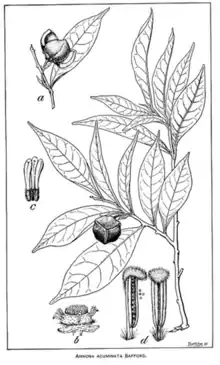Annona acuminata
Annona acuminata is a species of plant in the Annonaceae family. It is native to Panama, and Colombia.[1] William Edwin Safford, the American botanist who first formally described the species, named it after the tapering (acuminatus in Latin) tips of its leaves.[2][3]
| Annona acuminata | |
|---|---|
 | |
| Scientific illustration of Annona acuminata | |
| Scientific classification | |
| Kingdom: | Plantae |
| Clade: | Tracheophytes |
| Clade: | Angiosperms |
| Clade: | Magnoliids |
| Order: | Magnoliales |
| Family: | Annonaceae |
| Genus: | Annona |
| Species: | A. acuminata |
| Binomial name | |
| Annona acuminata | |
Description
It is a tree reaching 5 to 7 meters in height. Its branches have numerous red-brown lenticels. Its oblong, membranous leaves are 6.5-8 by 1.8-2.2 centimeters and smooth on both surfaces. Its leaves taper to a distinctive tip which at its apex is rounded. The leaves have 10-12 pairs of secondary veins emanating from its midrib. Its petioles are 1.5-3 millimeters long. Flowers are solitary on 16-16 millimeter long peduncles. The peduncles, which are extra-axillary, have two distinctive, 2-4 millimeter long bracteoles, one at their base, and one near their middle. Its sepals are partially fused to form a broad-based calyx with three triangular tips. The outside of the calyx is hairy and the inside has stiff rust-colored hairs at its base. Its flowers have numerous 2.5 millimeter long stamens. Its flowers numerous ovaries arranged in a disc, each with a 1.5 millimeter long, club-shaped style.[3] Its round, spiny fruit is 2-2.5 centimeters in diameter. Its yellow seeds are 7-8 millimeters long.[4]
Reproductive biology
The bright orange-yellow pollen of Annona acuminata is shed as permanent tetrads.[5]
References
- "Annona acuminata Saff". Plants of the World Online. The Trustees of the Royal Botanic Gardens, Kew. n.d. Retrieved December 22, 2018.
- Stearn, William (2004). Botanical Latin. Portland, Ore. Newton Abbot: Timber Press David & Charles. ISBN 9780881926279.
- Safford, William E. (1913). "Annona sericea and its Allies". Contributions from the United States National Herbarium. 16: 263–276.
- Woodson, Jr., Robert E.; Schery, Robert W. (1962). "Flora of Panama. Part IV, Fascile 5 (Nymphaeaceae to Monimiaceae)". Annals of the Missouri Botanical Garden. 49: 137–255. doi:10.2307/2394708. JSTOR 2394708.
- Walker, James W. (1971). "Pollen Morphology, Phytogeography, and Phylogeny of the Annonaceae". Contributions from the Gray Herbarium of Harvard University. 202 (202): 1–130. JSTOR 41764703.
- Borup-Grochtmann, I.; Kingston, David G. I. (1982). "Aporphine Alkaloids From Annona acuminata". Journal of Natural Products. 45 (1): 102. doi:10.1021/np50019a011. ISSN 0163-3864.